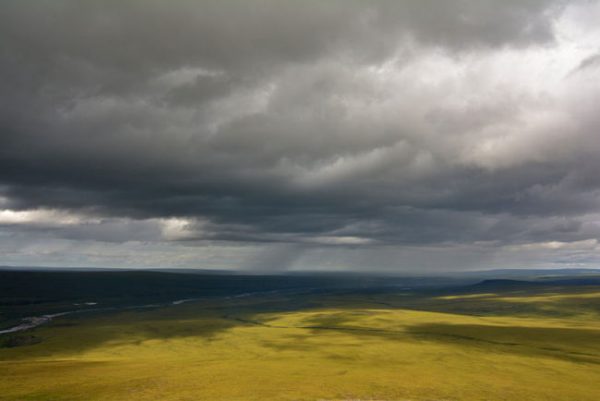
Biologists say early retreating sea ice is potentially causing vegetation productivity changes on the tundra across Alaska and the Arctic. Uma Bhatt, a climate variability expert with the University of Alaska–Fairbanks, says the land warms up more quickly when sea ice recedes earlier than usual.
“‘Cause the tundra is temperature limited and if it has more warmth available during the course of the summer, things can grow more,” Bhatt said. “That’s the first order effect, but what I think has happened is as the sea ice has gone away even further each year from the coast; there’s more time for open water, and that has led, I think, to increased cloudiness.”
Bhatt says more cloudiness can cool temperatures and potentially reduce plants’ photosynthetic activity or “greening.”
According to a publication recently released by the University of Alaska–Fairbanks and the International Arctic Research Center, the tundra on the North Slope has shown the most “greening” over the last five years than any other region in the state.
“But if you look at the Arctic as a whole, it’s greening, and the productivity is increasing,” Bhatt said. “But there’s a lot of spatial variability, and we think it has to do with what the permafrost is doing locally. If things are drying out locally, or if the snow patterns are changing, that’s going to affect what the vegetation is able to do.”
As Bhatt alluded to, there doesn’t seem to be one specific factor or explanation for the trend of significant greening, but on the North Slope increased shrub growth, general warming of the tundra, and more available moisture are possible contributors. According to climatologist Rick Thoman, sea ice extent near the North Slope in the Chukchi and Beaufort Seas is still shrinking. It’s currently less than 400,000 km, which is 37% of what used to be the average seasonal minimum.
Sea ice extent in the Beaufort and Chukchi Seas is still decreasing. Only 2012 and 2016 had significantly lower minimum extents. Current extent is only 37% of the pre-2000 average seasonal minimum. #akwx #seaice #Arctic @Climatologist49 pic.twitter.com/YhbMfnj00j
— Rick Thoman (@AlaskaWx) September 19, 2019
In stark contrast, the Yukon-Kuskokwim Delta has seen a decreasing Normalized Difference Vegetation Index (NDVI), or measured greening.
According to Skip Walker with UAF’s Institute of Arctic Biology, the lack of “greening” in the YK Delta doesn’t necessarily mean that the tundra and vegetation is “browning.”
“What is the actual cause of that is a mystery right now,” Walker said. “I don’t think we really understand it fully. And so that seems to be an area that really needs some research, as to what is the cause of that persistent trend and negative NDVI in the YK Delta.”
Walker has been working with Uma Bhatt to study tundra greening in the Arctic for more than a decade. Even though they are focusing on a larger area, Bhatt says the Seward Peninsula seems to be transitioning between the “greening” North Slope and the potential “browning” in the YK Delta.
Across Alaska and areas that Walker refers to as the low Arctic, satellite imagery shows an increasing number of shrubs popping up on the landscape. He says in the near future he expects to see shrubs growing in areas where they weren’t seen before.
“I think overall the increase in shrubs will eliminate a lot of the species’, what we could call, diversity,” Walker said. “The species diversity tends to go down when you have a lot of shrubs in the landscape, and that seems to be happening.”
And if shrub growth continues to increase eventually, Walker says the Alaska tundra will totally transform, but through a gradual process which may not finish during his lifetime.
According to Walker, these landscape changes, such as more shrubs and increased greening, will affect everything in Alaska. To see how wildlife, vegetation and humans living on the tundra could be affected down the line, Walker suggests keeping an eye out for the yet-to-be-released 2019 Arctic Report Card.
Correction: An earlier version of this story misspelled Uma Bhatt’s last name. It is Bhatt, not Bot.
Davis Hovey is a news reporter at KNOM - Nome.
Hovey was born and raised in Virginia. He spent most of his childhood in Greene County 20 minutes outside of Charlottesville where University of Virginia is located.
Hovis was drawn in by the opportunity to work for a radio station in a remote, unique place like Nome Alaska. Hovis went to Syracuse University, where he graduated with a Bachelor’s of Science in Broadcast Digital Journalism.




